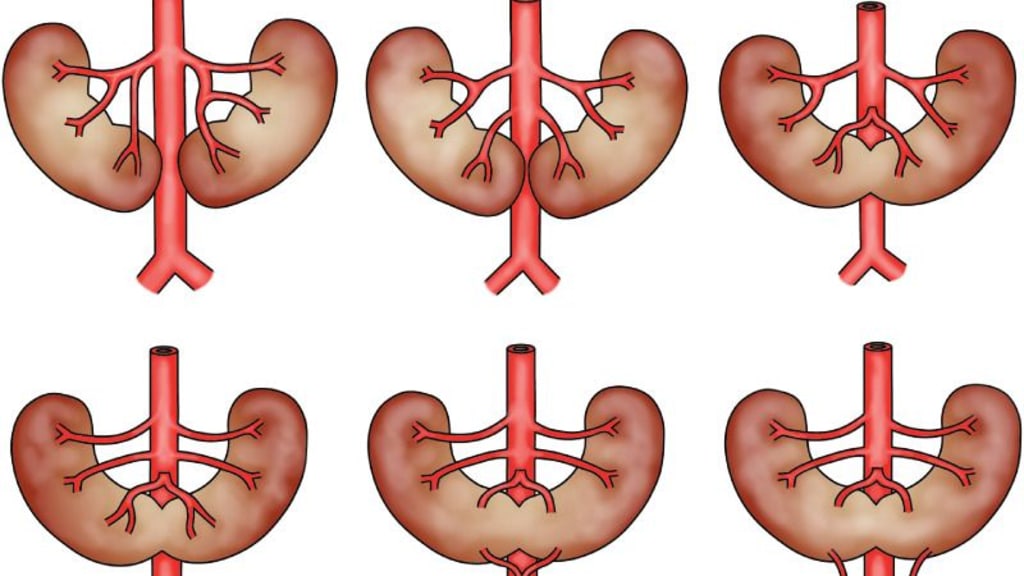Content warning
This story may contain sensitive material or discuss topics that some readers may find distressing. Reader discretion is advised. The views and opinions expressed in this story are those of the author and do not necessarily reflect the official policy or position of Vocal.
HORSESHOE KIDNEY
CAUSES, SYMPTOMS, AND SURGICAL INTERVENTIONS

Horseshoe kidney is a congenital kidney abnormality in which both kidneys are fused at the lower end, forming a U-shaped structure resembling a horseshoe. It may function normally but can be prone to certain complications.
When two kidneys are linked or fused, the result is a horseshoe kidney, also known as renal fusion. They conjure up the image of a horseshoe. The placement of a horseshoe kidney differs from that of two conventional kidneys. It is situated closer to the front of your body, lower in the pelvis.
As a newborn grows up before birth, the horseshoe kidney might form. All newborns’ kidneys begin to develop in the lower tummy. Afterwards, the kidneys usually ascend from the pelvic region and turn towards the back. In a horseshoe kidney, the kidneys join at their lower end rather than assuming regular positions on each side of the spine. They combine to create a U-shaped shape.
Horseshoe kidney imageHorseshoe kidney image
Narayana Health Contact Number
Causes of Horseshoe Kidney
The exact cause of horseshoe kidney is not well understood, but it is considered a congenital condition, meaning it occurs during fetal development. It is believed to result from an anomaly during early embryonic development, possibly due to genetic or environmental factors. Family history of kidney abnormalities can also play a role in predisposing individuals to horseshoe kidneys.
Although the exact cause of the horseshoe kidney is unknown, several variables do appear to increase the risk.
Horseshoe kidney is more likely to occur in people with particular genetic abnormalities. These illnesses include
The Edwards syndrome
The Turner syndrome
The Down syndrome
The presence of a horseshoe kidney does not indicate a person has a chromosomal problem. Other elements connected by researchers to the horseshoe kidney include
Pregnant women drinking alcohol.
Diabetes-related glycemic control.
Exposure to a variety of medications, including thalidomide, when pregnant.
Horseshoe kidney vs Normal kidneyHorseshoe kidney vs Normal kidney
Narayana Health Contact Number
Symptoms of Horseshoe Kidney
In about 7 out of 10 renal fusion patients, kidney issues are present. Many of these symptoms are indicators of problems with the horseshoe kidney.
Typical signs consist of
Abdominal aches in the abdomen
Nausea
Recurring urinary tract infections (UTIs) can be feverish and painful when urinating
Kidney stones can result in pain when urinating, hematuria, and stomach pain
Surgical interventions
Ureteral Reconstruction: Horseshoe kidneys can have abnormal positioning of the ureters, which are the tubes that carry urine from the kidneys to the bladder. Surgical correction may be necessary to reposition or reconstruct the ureters if they become obstructed or cause urinary flow problems.
Stone Removal: People with horseshoe kidneys may be more prone to kidney stones due to their unique kidney anatomy. Surgical procedures may be required to manage kidney stones, such as lithotripsy (breaking up stones with shock waves) or endoscopic stone removal.
Treatment of Complications: Horseshoe kidneys can be associated with various complications, such as urinary tract infections, kidney blockages, or vascular issues. Surgical intervention may be necessary to address these complications.
Nephrectomy: In some cases, if one part of the horseshoe kidney is causing severe problems or is nonfunctional, surgical removal of that portion (partial nephrectomy) or even the entire horseshoe kidney (nephrectomy) may be considered.
Urological Reconstruction: Reconstruction of the urinary tract may be needed to correct anatomical abnormalities or improve urinary drainage.
Transplantation: Rarely, in cases of severe horseshoe kidney complications or when both kidneys are nonfunctional, a kidney transplant may be an option. The transplanted kidney is typically placed in the pelvis, and the horseshoe kidney may or may not be removed.
If no symptoms exist, treatment might not be required. Although there is no cure for the horseshoe kidney, the symptoms can be managed if they pose a threat (“supportive treatment”). Patients with horseshoe kidneys frequently have a blockage, which is the inability of urine to pass freely, and vesicoureteral reflux, which is the inability of urine to flow backwards from the bladder. Both of these are surgically fixable.
More frequently than a normal kidney, a horseshoe kidney is positioned lower and considerably closer to the front of the body. Furthermore, compared to a normal kidney, it is more vulnerable to injury in the event of abdominal trauma. Emergency personnel will be made aware of the potential for kidney damage if the wearer of a medical alert bracelet is present.
The course of treatment might include
Antibiotics for urinary tract infections
Kidney stones are removed surgically.
The control of pain
About the Creator
Enjoyed the story? Support the Creator.
Subscribe for free to receive all their stories in your feed. You could also pledge your support or give them a one-off tip, letting them know you appreciate their work.





Comments
There are no comments for this story
Be the first to respond and start the conversation.